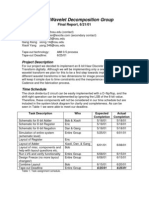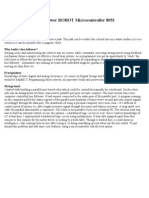A Four Channel X - Y Oscilloscope Multiplexer
A Four Channel X - Y Oscilloscope Multiplexer
Uploaded by
GaryTechCopyright:
Available Formats
A Four Channel X - Y Oscilloscope Multiplexer
A Four Channel X - Y Oscilloscope Multiplexer
Uploaded by
GaryTechOriginal Description:
Original Title
Copyright
Available Formats
Share this document
Did you find this document useful?
Is this content inappropriate?
Copyright:
Available Formats
A Four Channel X - Y Oscilloscope Multiplexer
A Four Channel X - Y Oscilloscope Multiplexer
Uploaded by
GaryTechCopyright:
Available Formats
A four channel X/Y oscilloscope multiplexer
1 of 7
http://www.analogmuseum.org/english/homebrew/scope_multiplexer/
A four channel X/Y oscilloscope multiplexer
Although I have some Tektronix oscilloscopes with appropriate plug in units yielding an four channel
display, I always wanted something else: A true four channel oscilloscope with four distinct X/Y
inputs which would allow me not only to display four traces with a common X deflection but to draw
up to four distinct figures on the screen at the same time.
Something like this is very useful in conjunction with an analog computer, i.e. one can display
different movong masses in a simulation at once, etc. This led to the development of such multichannel
X/Y oscilloscopes like the truly wonderful Telefunken OMS 811 dual channel oscilloscope.
Although I am the proud owner of such an instrument, its limitation to only two channels was a bit
disappointing (currently I want to simulate a multiple spring-mass-system and display all moving
masses at once to get a feeling for the forces of the system), so decided to build my own multiplexer.
The front plate of the instrument can be seen later - below is a picture taken during the calibration of
the multiplexer (it is a bit blurry - sorry for the bad quality - I desperately need a camera fixture for my
oscilloscopes) - four Lissajous figures displayed at once (it is always the same figure since, it is some
kind of a proof of concept picture):
The basic structure of the multiplexer is simple, although it was one of the more complex projects I
implemented during the last years which is due to the fact of the excessive cabling necessary for all of
the control elements on the front (and back) plate:
10/31/2014 11:01 PM
A four channel X/Y oscilloscope multiplexer
2 of 7
http://www.analogmuseum.org/english/homebrew/scope_multiplexer/
There are four X and Y inputs on the front plate using banana jacks and on the back plate using
a 15 pole SUB-D connector. Using a switch on the front plate one of these signal sources can be
activated using two rather large relays (since this is not time critical and will be done only
during startup, I preferred relays over semiconductor multiplexers here). The front panel input
jacks will be used for stand alone operation while the back panel input connector will be used
when the multiplexer will become an integral part of a larger analog computer where the input
lines will be tied to the central patch panel by appropriate trunk lines.
Each of the eight inputs is fed to a ten turn precision potentiometer for input attenuation before
being fed through an impedance converter to remove any load from the potentiometers, thus
assuring a linear behaviour.
Following these converters the signals are fed through an additional operational amplifier stage
with an amplification rate of 10 which is also used to add a constant position signal to allow the
shifting of each of the four figures.
Following these operational amplifier stages comes the multiplexer, a MAX 355 which is a dual
4:1 analog multiplexer. This multiplexer receives to binary counter signals and feeds two output
stages built from OP27 operational amplifiers driving the X/Y input lines of the oscilloscope
connected to the multiplexer.
The tricky part is the blanking logic since I did not want to see faint lines between the figures
when the beam moves from drawing one figure to the next. In addition to this the blanking logic
allows the selection of one, two, three or four indepentent figures to be displayed
simultaneously.
The picture on the left shows the front plate.
From left to right you find the following control
element groups:
12 banana jacks (5 times ground, 4 times X, 4 times Y, 1 input to deactivate the oscilloscope
output during halt and initial value times of the analog computer).
4 green LEDs showing the active channels, one yellow LED which is lit when the oscilloscope
beam is blanked.
Three BNC jacks for X, Y and Z output to the oscilloscope.
A four position rotary switch to select the number of individual channels to be displayed
concurrently (the blanking logic guarantees that the intensity of the display will not change with
the number of figures displayed!).
Four groups of two ten turn precision potentiometers for signal attenuation and two single turn
potentiometers for changing the position.
The power switch with two power LEDs (one for the positive supply, one for the negative) and
one switch to select between front panel input and back panel input.
10/31/2014 11:01 PM
A four channel X/Y oscilloscope multiplexer
3 of 7
http://www.analogmuseum.org/english/homebrew/scope_multiplexer/
The pictures above give an impression of the immense amount of cabling necessary to connect all of
the front panel control elements to the remaining circuitry of the multiplexer.
The power supply, shown on the right, is quite
simple. I used a toroidal core transformer yielding 2
x 18 V with 800 mA each, followed by three
integrated voltage regulators (7815, 7915 and 7805
for the blanking logic). The rectifier is way too large
but was the only one I found when I started building
the device.
Shown on the left are the two input selector
relays - fortunately I found two relays with six
contact pairs each - eight contact pairs are
needed to switch between the eight front panel
X/Y input jacks and the back panel connector
while another contact pair is needed to switch
the blanking input between these two sources,
so nine out of twelve contact pairs are utilized.
The two pictures above show the central circuit board (component side view on the left, soldering side
view on the right). Next to the VG connector are the operational amplifiers, the calibration
potentiometers and the multiplexer IC itself. The other half of the board is populated with the blanking
10/31/2014 11:01 PM
A four channel X/Y oscilloscope multiplexer
4 of 7
http://www.analogmuseum.org/english/homebrew/scope_multiplexer/
logic and associated driver circuitry. Some passive components are used to yield proper input voltages
for the position setting potentiometers.
The picture on the right shows the overall
multiplexer - the right half of the drawer is occupied
by the (small) power supply, the left half houses the
multiplexer electronics itself and the input selector
relays. (The picture was taking during the test
phase, thus the additional cables.)
The picture on the left shows the back panel of
the multiplexer. Next to the input power
connector are three BNC jacks delivering the X,
Y and Z signals to the oscilloscope (these are
just paralleled to the corresponding jacks on the
front plate) and the already mentioned 15 pin
SUB-D connector.
Shown on the right is a photo taking during the
calibration phase. Since the MAX 355 multiplexer
has a non zero resistance, the attenuation effect
caused by this has to be corrected by the output
operational amplifiers (OP27). To calibrate the
multiplexer, I used a 1 kHz, 2 Vpp input signal for
X and Y, set all attenuator potentiometers to 0.1 and
adjusted the two calibration potentiometers mounted
on the central circuit board for an output signal of 2
Vpp. (The attenuation by 0.1 will be compensated
by the intrinsic amplification by a factor of 10.)
10/31/2014 11:01 PM
A four channel X/Y oscilloscope multiplexer
5 of 7
http://www.analogmuseum.org/english/homebrew/scope_multiplexer/
The four pictures above show the effect of the multiplexer with the channel number selector set to one,
two, three and four channels respectively. Please note that the intensity of the picture does not vary
with the number of channels displayed (due to a trick in the blanking logic :-) ).
The picture above shows the power supply schematic - it bears nothing special at all, the two signal
+POS and -POS are the feeder voltages for the position control potentiometers on the front plate, the
two relays are the input selector relays mentioned above.
10/31/2014 11:01 PM
A four channel X/Y oscilloscope multiplexer
6 of 7
http://www.analogmuseum.org/english/homebrew/scope_multiplexer/
The schematic above shows the multiplexer circuitry of the device. Please note that the input section
will be needed eight times, occupying four TL084 chips (and lots of wires to the front panel
potentiometers). The 50k (10 turn) potentiometers in the feedback path of the OP27 operational
amplifiers are used for the calibration of the multiplexer device.
The clock generation circuitry is shown in the schematic above. An astable multivibrator made from
an NE555 drives a two stage counter consisting of two JK flip flops used in a T flip flop configuration.
The respective Q outputs of these flip flops are used to drive the MUX while the active low clock
signal /CLK will be used for the following blanking logic.
10/31/2014 11:01 PM
A four channel X/Y oscilloscope multiplexer
7 of 7
http://www.analogmuseum.org/english/homebrew/scope_multiplexer/
The blanking logic shown in the schematic above generates an appropriate blanking signal to dim the
oscilloscope's beam during beam movements between figures. Furthermore this Z signal can be used
to suppress one to three of the maximum of four figures displayed simultaneously without having to
readjust the beam intensity
The operational amplifier (OP27) is used to drive the Z signal for the oscilloscope - with the aid of the
potentiometer the polarity and pulse height can be adjusted to match most common oscilloscope's Z
axis inputs. (For example: My HP 180C oscilloscope expects a +2 V pulse to dim the beam while
ground potential at the Z input will display the beam in normal intensity.)
ulmann@analogmuseum.org
09-OCT-2006, 26-JAN-2008
10/31/2014 11:01 PM
You might also like
- Anacom 1-1 1-2Document46 pagesAnacom 1-1 1-2hellboytonmoy67% (3)
- VCO Produces Positive and Negative Output Frequencies PDFDocument4 pagesVCO Produces Positive and Negative Output Frequencies PDFagmnm1962100% (1)
- Final Lab ProjectDocument11 pagesFinal Lab Projectapi-509710759No ratings yet
- Automatic Car Parking System Using 89c51 MicrocontrollerDocument61 pagesAutomatic Car Parking System Using 89c51 MicrocontrollerAnil Tandon63% (16)
- Project ReportDocument23 pagesProject Reportggngg67% (3)
- The Seven Segment DisplayDocument5 pagesThe Seven Segment DisplayTewodros Kassahun100% (2)
- Artist A Net Manual V1.2 30.06Document27 pagesArtist A Net Manual V1.2 30.06GaryTechNo ratings yet
- DSD Lab Manual AitdDocument31 pagesDSD Lab Manual Aitdprathameshbhat88No ratings yet
- ECNG 3016 Advanced Digital Electronics: Eneral NformationDocument10 pagesECNG 3016 Advanced Digital Electronics: Eneral NformationMarlon BoucaudNo ratings yet
- Lab 8Document8 pagesLab 8Anonymous yG7oj20% (1)
- Automatic Traffic Signal ControllerDocument32 pagesAutomatic Traffic Signal Controllerrakeshcusat89100% (1)
- Training Report (Vol-III)Document11 pagesTraining Report (Vol-III)Deepak BoraNo ratings yet
- Lab #1 Logic Gates: ObjectiveDocument6 pagesLab #1 Logic Gates: ObjectiveZbiggNo ratings yet
- Using Overture Design GuideDocument5 pagesUsing Overture Design Guideeleceng1979No ratings yet
- Block Proving With Axle CounterDocument21 pagesBlock Proving With Axle CounterVikas Srivastav100% (4)
- Ing. Angelo Farina: Dipartimento Di Ingegneria IndustrialeDocument6 pagesIng. Angelo Farina: Dipartimento Di Ingegneria IndustrialeemilianomathieuNo ratings yet
- Square Wave Generator Using Op-AmpDocument7 pagesSquare Wave Generator Using Op-AmpArunNo ratings yet
- Term Project Topic: Function of Cro (Cathod Ray Osciiloscope) & Application of Function GeneratorDocument5 pagesTerm Project Topic: Function of Cro (Cathod Ray Osciiloscope) & Application of Function Generatorshailesh singhNo ratings yet
- (Experiment 7) Operational Amplifier - Basic Op-Amp Circuit (Comparator, Summing, Integrators, and Differentiators) PDFDocument13 pages(Experiment 7) Operational Amplifier - Basic Op-Amp Circuit (Comparator, Summing, Integrators, and Differentiators) PDFArik JuniarNo ratings yet
- Axle CounterDocument15 pagesAxle CounterSourav MahatoNo ratings yet
- DPScope SE Design Description PDFDocument11 pagesDPScope SE Design Description PDFingenierognvNo ratings yet
- Emi Lab Manual PDFDocument39 pagesEmi Lab Manual PDFMadhusudhanan RamaiahNo ratings yet
- Digital Wavelet Decomposition GroupDocument10 pagesDigital Wavelet Decomposition GroupkjnanduNo ratings yet
- Line Follower ROBOT Micro Controller 8051Document28 pagesLine Follower ROBOT Micro Controller 8051Rohit XavierNo ratings yet
- LC Meter With The 89C2051Document8 pagesLC Meter With The 89C2051Manch PssNo ratings yet
- ABB I-Bus Eib / KNX Switch Actuator, X-Fold, 16 A, MDRC SA/S x.16.1, 2CDG 110 0xx R0011Document4 pagesABB I-Bus Eib / KNX Switch Actuator, X-Fold, 16 A, MDRC SA/S x.16.1, 2CDG 110 0xx R0011pkmhussainNo ratings yet
- Pattern Shifting With Different Frequencies - ReportDocument19 pagesPattern Shifting With Different Frequencies - ReportChristopher EarnshawNo ratings yet
- Laboratory Manual Course Code:Ece 201Document41 pagesLaboratory Manual Course Code:Ece 201Er Sacchu SrivastavaNo ratings yet
- Transistor Curve Tracer 001Document2 pagesTransistor Curve Tracer 001pecceriniNo ratings yet
- Scrolling 16 2 Led in PICDocument23 pagesScrolling 16 2 Led in PICmalhiavtarsingh100% (3)
- Lab 4 - Motor Speed Control With Lead Compensator and Integral ControlDocument7 pagesLab 4 - Motor Speed Control With Lead Compensator and Integral ControlAnimesh GhoshNo ratings yet
- REN - Reduce Swap Telecom Payload Satellite Command Telemetry Subsystems - WHP - 20190515Document8 pagesREN - Reduce Swap Telecom Payload Satellite Command Telemetry Subsystems - WHP - 20190515Vasudev PurNo ratings yet
- ANALOG Electronics Lab ManualDocument67 pagesANALOG Electronics Lab ManualNavin BhaskarNo ratings yet
- Information On Some of The Parts in PSpice LibrariesDocument8 pagesInformation On Some of The Parts in PSpice Librarieshamza abdo mohamoudNo ratings yet
- Lab HandoutDocument23 pagesLab HandoutmariyabmeNo ratings yet
- Circuit Logic User GuideDocument59 pagesCircuit Logic User Guideঅন্তরআত্মারসন্ধানে100% (1)
- DIY k180Document8 pagesDIY k180jisteeleNo ratings yet
- 2449 Ex4Document15 pages2449 Ex4JC ZuletNo ratings yet
- Design, Construction and Operation of An Electronic Music Synthezizer (Old Book)Document141 pagesDesign, Construction and Operation of An Electronic Music Synthezizer (Old Book)fidel.certuche100% (1)
- Exp 03 Function Generator Using 741 Op-AmpDocument4 pagesExp 03 Function Generator Using 741 Op-Ampkaushal4053100% (2)
- L #6: L C C S L G: Sfsu - E 301 - E L AB Ogic Ircuit Haracteristics and Imple Ogic AtesDocument11 pagesL #6: L C C S L G: Sfsu - E 301 - E L AB Ogic Ircuit Haracteristics and Imple Ogic AtesRudra MishraNo ratings yet
- Function GeneratorDocument13 pagesFunction GeneratorDilJalaayNo ratings yet
- University of Essex: School of Computer Science andDocument18 pagesUniversity of Essex: School of Computer Science andVlad SimizeanuNo ratings yet
- Analog and Digital Electronics (Ade) Lab Manual by Prof. Kavya M. P. (SGBIT, BELAGAVI)Document74 pagesAnalog and Digital Electronics (Ade) Lab Manual by Prof. Kavya M. P. (SGBIT, BELAGAVI)Veena B Mindolli71% (7)
- ITE1001 LTP J C 3 0 2 0 4 Pre-Requisite NIL Syllabus VersionDocument5 pagesITE1001 LTP J C 3 0 2 0 4 Pre-Requisite NIL Syllabus VersionYash KNo ratings yet
- Electronic Measurement & Instrumentation Lab Lab Manual: Vi SemesterDocument41 pagesElectronic Measurement & Instrumentation Lab Lab Manual: Vi SemesterMy JaanNo ratings yet
- PCB Lab ReportDocument9 pagesPCB Lab Reportpratik kumarNo ratings yet
- Basic Electronics Circuits: Experiment 1Document9 pagesBasic Electronics Circuits: Experiment 1SavithaGnNo ratings yet
- ELVIS AC Circuit ToolsDocument7 pagesELVIS AC Circuit ToolsHermes Polanco100% (1)
- TCL Chasis M113 TMPA8809 Manual ServicioDocument90 pagesTCL Chasis M113 TMPA8809 Manual ServicioCarlos A. Torres0% (1)
- ElectronicsDocument8 pagesElectronicsmadhu chandrikaNo ratings yet
- Cadence - Virtuoso: Amity UniversityDocument27 pagesCadence - Virtuoso: Amity UniversityAkhil Aggarwal100% (1)
- Operation AmplifiersDocument17 pagesOperation AmplifiersJohn Lomba100% (1)
- Dual Trace OscilloscopeDocument8 pagesDual Trace OscilloscopeSudip MondalNo ratings yet
- Experiment 2 Basic Operational Amplifier CircuitsDocument7 pagesExperiment 2 Basic Operational Amplifier CircuitsVasursharpNo ratings yet
- MFOS Echo RockitDocument18 pagesMFOS Echo RockitJosé Brito NetoNo ratings yet
- ADE Lab Manual PDFDocument90 pagesADE Lab Manual PDFAkhendra KumarNo ratings yet
- BMC039. Step Sequencer.Document6 pagesBMC039. Step Sequencer.Maarfy CZNo ratings yet
- IOE Instrumentation Lab ManualDocument14 pagesIOE Instrumentation Lab ManualDivya KarkiNo ratings yet
- Analog Dialogue, Volume 48, Number 1: Analog Dialogue, #13From EverandAnalog Dialogue, Volume 48, Number 1: Analog Dialogue, #13Rating: 4 out of 5 stars4/5 (1)
- Ford Taurus SE Failed Smog Check Monitors Not ReadyDocument1 pageFord Taurus SE Failed Smog Check Monitors Not ReadyGaryTechNo ratings yet
- Creamy Vegan Cheese Sauce - BLOG - Eatplant-BasedDocument10 pagesCreamy Vegan Cheese Sauce - BLOG - Eatplant-BasedGaryTechNo ratings yet
- Software License Agreement: Article 4 Right Pertaining To The Licensed SoftwareDocument2 pagesSoftware License Agreement: Article 4 Right Pertaining To The Licensed SoftwareGaryTechNo ratings yet
- Pic 24 FJ 256 Da 210Document408 pagesPic 24 FJ 256 Da 210GaryTechNo ratings yet
- Features: Single Bilateral SwitchDocument15 pagesFeatures: Single Bilateral SwitchGaryTechNo ratings yet
- Single Bilateral Switch: Order CodesDocument11 pagesSingle Bilateral Switch: Order CodesGaryTechNo ratings yet
- MCP2515 CAN Bus Monitor Demo BoardDocument28 pagesMCP2515 CAN Bus Monitor Demo BoardJosé Luiz CitolinoNo ratings yet
- Gsu100 6648-0.0Document16 pagesGsu100 6648-0.0Anonymous lWbDz3enXNo ratings yet
- Área Personal V-2020-C-2-1450-2849-ING-110 Module 1 Test: Mis CursosDocument5 pagesÁrea Personal V-2020-C-2-1450-2849-ING-110 Module 1 Test: Mis CursosAnnethy Paola Javier MonteroNo ratings yet
- Inclined Planes AND Mechanical AdvantageDocument3 pagesInclined Planes AND Mechanical Advantageaejmpap2016No ratings yet
- Design of Switched Reluctance Motor For Three Wheeler Electric VehicleDocument4 pagesDesign of Switched Reluctance Motor For Three Wheeler Electric VehicleidescitationNo ratings yet
- ABB HMI CP607 Data SheetDocument6 pagesABB HMI CP607 Data SheetRadu BabauNo ratings yet
- HT BushingDocument1 pageHT Bushingindrajit mondalNo ratings yet
- Planos Rocker Boomer 282Document68 pagesPlanos Rocker Boomer 282ELVIS MAQUERA CHOQUEMOROCONo ratings yet
- Foster Wheeler Bengal Pvt. LTD.: Piping DepartmentDocument27 pagesFoster Wheeler Bengal Pvt. LTD.: Piping Departmentsubhadip sadhukhanNo ratings yet
- Diagramas Caterpillar RENR1245 - 02Document2 pagesDiagramas Caterpillar RENR1245 - 02jorge antonio guillenNo ratings yet
- Tms 320 F 2808Document146 pagesTms 320 F 2808Bui van DinhNo ratings yet
- Siemens SWGR PDFDocument56 pagesSiemens SWGR PDFSalmanEjazNo ratings yet
- Rundown TankDocument3 pagesRundown TankRadhakrishnan SreerekhaNo ratings yet
- BMW GS6-17BG-5Document7 pagesBMW GS6-17BG-5Jordy PerezNo ratings yet
- HHC Medium Voltage Fuses For Capacitors: Features/BenefitsDocument12 pagesHHC Medium Voltage Fuses For Capacitors: Features/BenefitsMahmoudMotamediNo ratings yet
- 25 KV CT PDFDocument34 pages25 KV CT PDFmanishNo ratings yet
- All Ranges Brochure 2022Document20 pagesAll Ranges Brochure 2022tariq maroufNo ratings yet
- VW Tiguan 2 Electrical System EngDocument321 pagesVW Tiguan 2 Electrical System Engeng.alvarengaNo ratings yet
- BL8023C Datasheet V1.5Document6 pagesBL8023C Datasheet V1.5hombre pocilgaNo ratings yet
- EV Connection Offering EV Charging As An Amenity To Zehn Bukit PantaiDocument3 pagesEV Connection Offering EV Charging As An Amenity To Zehn Bukit Pantaiyogapost100% (1)
- 2.5l Cec SystemDocument37 pages2.5l Cec Systemdaniel lacerdaNo ratings yet
- Cisco 95 Series Unmanaged SwitchesDocument9 pagesCisco 95 Series Unmanaged SwitchesMP InfraprojectNo ratings yet
- Brochure GPAC70-210 Air CooledDocument10 pagesBrochure GPAC70-210 Air CooledAva AlonserNo ratings yet
- MERCURY 30 40 HP Instruktsiya Po Zamene Svechey Zazhiganiya I Rem - Komplekta Pompy Sistemy OhlazhdeniyaDocument4 pagesMERCURY 30 40 HP Instruktsiya Po Zamene Svechey Zazhiganiya I Rem - Komplekta Pompy Sistemy OhlazhdeniyaScott BakerNo ratings yet
- Sample Offer-P ProliftDocument5 pagesSample Offer-P ProliftВячеслав ЯкимовNo ratings yet
- Over Currrent / Earth Fault Relay Field Test: Project NameDocument1 pageOver Currrent / Earth Fault Relay Field Test: Project NamemkarimiloloNo ratings yet
- SHEF50/SHEF100: Submersible Effluent PumpDocument12 pagesSHEF50/SHEF100: Submersible Effluent Pumpallen_worstNo ratings yet
- EKM OmniMeter UL User Manual Spec Sheet SubmeterDocument3 pagesEKM OmniMeter UL User Manual Spec Sheet SubmeterAdam BrouwerNo ratings yet
- 2019 Audi A5 BrochureDocument17 pages2019 Audi A5 BrochureVishal NaikNo ratings yet
- LG lrm-519 (ET)Document158 pagesLG lrm-519 (ET)joeblow44No ratings yet
- Lister PeterDocument30 pagesLister Petercpaolinod100% (2)

































































































